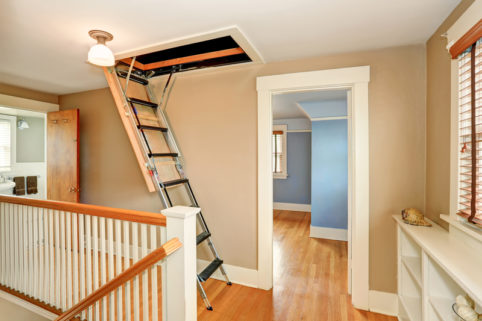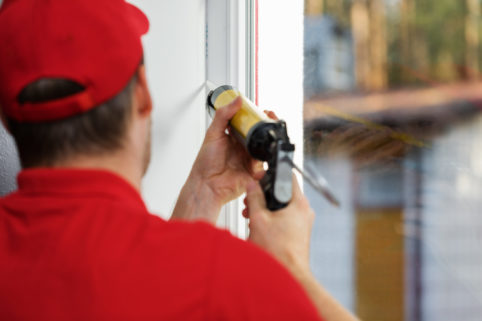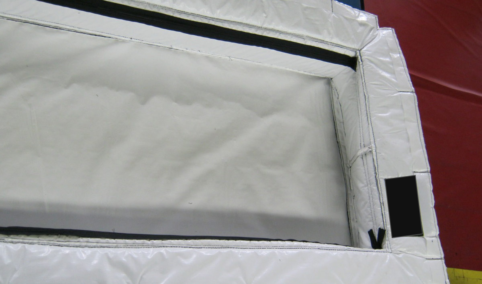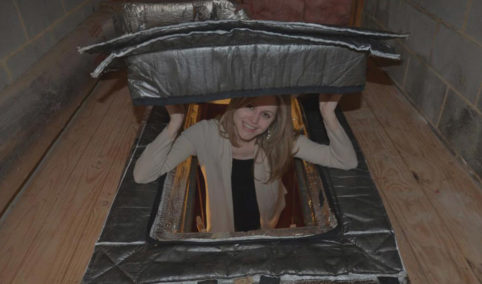In the winter, many homeowners face a common problem — drafts.
Naturally, as the temperature outside takes a dive, the indoor temperature trends in the same direction.
The heater gets turned up, the fireplace starts getting used, and your energy bill starts running through your mind more and more.
While air sealing is important throughout the house (see exactly where, here), one of the main culprits of drafts is the attic door.
When your attic hatch or scuttle hole is improperly sealed, it can result in an uncomfortable living environment and needless energy inefficiency.
That’s why it’s important to know how to stop drafts from your attic door.
We’ve put together these tips to help you stop this common household issue.
How To Stop Drafts From Your Attic
Tip 1: Inspect Your Attic and The Access Door
Seems simple enough, right?
Still, this easy tip eludes too many homeowners, who grow accustomed to certain living conditions. But the first step in improving your attic’s draftiness is assessing the attic door’s condition overall.
Many major issues in a home are a trickle-down side effect from a larger, house-wide issue, and a simple draft from the attic door can be a good indicator that your home’s sealing should be inspected overall. The first step should be a general analysis of the obvious source: the attic access door. Before you can fix the whole home, you will need to figure out what your attic is working with.
The primary attic elements you will need to review are the attic access door, the ventilation within the attic, and the insulation within the attic. All of these elements impact an attic’s energy efficiency, and moreover, impact how drafty the attic is overall.
When looking at your attic access door, take a close look at how tight the door is to its frame when closed. The space between the attic access door and its frame is the most obvious path of passage between the attic and the rest of the home. Be sure to inspect this spacing from outside the attic and inside the attic. Depending on your home’s lighting, one view may illuminate a gap that you cannot perceive from the other side.
Tip 2: Properly Seal Your Attic Access and Attic Hatch
Once you take a closer look, you will be able to identify where your attic hatch needs immediate attention. The solution is often proper sealing. Whether it be the hatch, parts of the door, or loose elements of the frame, sealing can help remedy many of the sources of your home’s drafts.
When it comes to attics, the best solution for attic sealing issues is often caulking. If you’ve never used a caulk gun before, they are typically available at any local or national chain hardware store and are fairly straightforward to control. The goal is to fill up all the open gaps in your attic access hatch, and once filled, negate the effects of drafts on the rest of your home.
Outside of drafts originating from your attic, caulking can be a great solution anywhere in the home. Some drafts may require ulterior methods of prevention, such as weatherstripping or additional insulation.
To find out even more about air sealing in general, visit Seal, Insulate & Ventilate, a premier information center for homeowners and industry professionals alike.
Caulk guns will definitely help you stop your drafts, but for homeowners who don’t want to repeatedly caulk and are faced with a more long-term sealing problem, a long-term solution should be used.
Tip 3: Get the Right Equipment to Limit Attic Drafts
The underlying principle behind sealing with caulk is this: keep your attic air separate from the air in the rest of your home.
While caulk can do the trick, you may find that you need to apply caulk more and more if there is a bigger issue in your attic (e.g. moisture problems). For those looking for a durable and reliable solution, an attic access cover should be seriously considered.
Above, we can see an attic access cover prior to installation.
Here is a look at an attic access cover from the inside.
Attic Access Cover Benefits
Attic access covers help reduce the air leaking problem in your house, but they also can help solve another larger issue.
As we discussed previously, problems in the home can be the trick-down side-effects of larger problems. In the case of air leakage from attic doors, the “larger problems” could potentially be ventilation issues in your attic or low home energy efficiency (which adds to your monthly energy bills).
Installing an attic access cover could help solve multiple problems with one installation.
Features and benefits of attic access covers include:
- Fewer drafts, stronger attic sealing
- Reduce chances of rodent or pest infestation in the attic
- Long-term durability and dependency (doesn’t rip from contact with attic stairs)
- Designed to fit around scuttle holes and be used in most attic structures
As you delve deeper into the core problems that your attic draft could come from, you should inspect your entire attic. You may have a larger insulation issue.
Tip 4: Insulate and Seal the Rest of Your Attic
For those looking to attack the heart of the issue and take a holistic approach by improving the home’s overall quality, insulating your entire attic is the most effective option.
Of course, sealing your entire home is also important. For an intro on why sealing your home is important, you can also watch this short video from the experts from Seal Insulate and Ventilate.
Consider the following aspects of your attic:
- Attic Access – Check your attic door/scuttle hole for gaps, crack, and holes
- Floor – Take a look at the insulation on your attic floor. Is it fully intact or does it need to be replaced?
- Structural – Take a look at your attic’s joists and knee walls. Are they full covered or do they need better insulation?
There are many types of insulation that you can use your attic — it’s all about knowing what you need. As you learn more, a key factor that homeowners can really pay attention to is “R-Value.”
If you want to learn more about how to choose attic insulation, visit this recent article.
Keeping the importance of sealing in mind, it may very well be worth it to contact a professional — which leads us to tip number 5.
Tip 5: Get An Attic Inspection
When you are taking a look around, you may very well find that there are more issues in your attic than you expected.
Bad insulation on your attic walls? Damaged wood? You might start to think, “Is this what my attic is supposed to look like?”
If you’re asking yourself similar questions, you are not alone. Non-surprisingly, the attic is overlooked by many homeowners. It is often used for storage (or in the rare case, trash) and little else.
Moreover, it’s kind of hard to tell that there is an issue when 1) you aren’t looking on a regular basis and 2) you don’t know exactly what to look for.
When you get an inspection, you can expect your problem to be fixed.
Yellowblue™ is ready to help homeowners with their attic drafts. Contact an independent authorized yellowblue™ dealer today to discuss the best way to go about fixing your attic draft. Backed by experience, yellowblue™ contractors have the experience to offer personalized advice for any attic issues — especially attic drafts!









